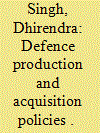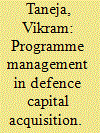| Srl | Item |
| 1 |
ID:
142343


|
|
|
| 2 |
ID:
130998


|
|
|
|
|
| Publication |
2014.
|
| Summary/Abstract |
While space capabilities were once concentrated among a handful of leading powers, an increasingly large number of states have gained access to them. As of 2007, 58 countries possessed dedicated civil space programs, 44 countries had placed nationally owned satellites into orbit, and 9 countries had achieved domestic space launch capabilities. To date, however, no systematic inquiries have ever been conducted into which countries acquire space capabilities and why. Within this paper, I develop an explanatory account that explores the capacity-based factors and political motivations that influence countries' acquisition of space capabilities. I test my hypotheses via a quantitative analysis of the factors affecting 143 countries' acquisition of civil space programs, satellite capabilities, and space launch capabilities from 1950 to 2002. My findings shed new light on the primary causes of the proliferation of civil space capabilities and yield a number of important policy implications
|
|
|
|
|
|
|
|
|
|
|
|
|
|
|
|
| 3 |
ID:
139175


|
|
|
|
|
| Summary/Abstract |
The Indian acquisition canvas in these times is exemplified more by its failings than its accomplishments. Two accidents, one of them fatal, involving utility helicopters in February 2015, have yet again brought to the fore the grim reality of the material readiness in the Indian armed forces, the reluctant clients to a sub-optimal acquisition apparatus. Defence capital acquisition the world over, by its very nature, is a highly rigorous, time consuming and resource intensive domain. In India, acquisition involves multifarious directorates in the Service Headquarters, the Acquisition Wing in the Ministry of Defence (MoD) and the Department of Defence Production (DDP) embodying India’s burgeoning Military Industrial Complex (MIC). Regrettably, India’s armed forces, despite being the biggest arms importer in the world, endure hollowness of critical military equipment. Multiple high level committees since independence have recommended a slew of acquisition reforms, with little realisation on the ground.1 India’s defence modernisation has often been described as a parochial Army effort without the benefit of strong political direction
|
|
|
|
|
|
|
|
|
|
|
|
|
|
|
|